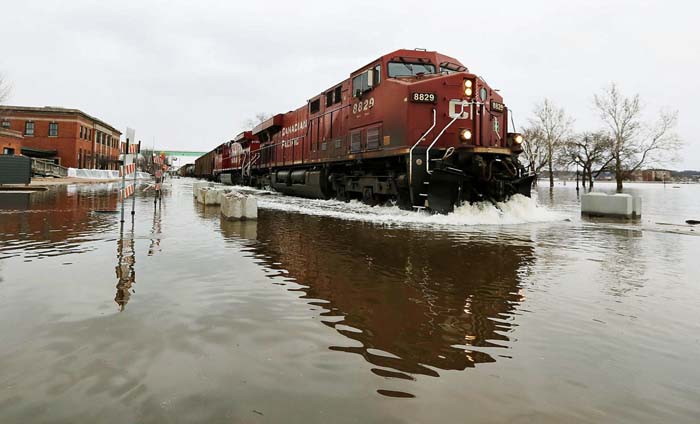
Davenport Iowa USA - When River Drive was briefly reopened downtown last week, sections of the Mississippi riverfront remained
inaccessible.
Floodwaters from the record setting crest receded to the extent that city workers were able to temporarily remove the row of HESCO barriers and clear the dirt
and debris from the roadway.
In that brief window, Canadian Pacific Railway (CP) was able to make one downtown rail crossing accessible to the public again.
In late March, the company began raising the tracks to get its trains through the floodwater.
CP indicated the tracks were being permanently raised as much as 20 inches, but some sections of track appear to have been raised considerably more than
that.
State law requires the railroad company to restore the crossings to a passable condition within 30 days of the time floodwaters recede from parallel
roadways.
The clock would have started ticking last week with the clearing of River Drive (U.S. 67), but the return of the HESCO barriers and another crest forecast are
resetting the clock.
But some progress was made.
"In consultation with the city of Davenport, CP is installing four temporary crossings in downtown Davenport," company spokesman Andy Cummings wrote
in an email late last week.
"Marquette Street is complete, Perry Street and Harrison Street are in progress, and work is planned for next week at Gaines Street.
"CP will continue to progress work at these crossings as weather allows."
The crossing at the entrance to River Heritage Park also remains inaccessible, due to the height of the tracks.
However, the sandbags that protect the raised rail remain in place, pending the next crest.
The city was neither required to approve of nor inspect Canadian Pacific's work.
The rail raising was done within the company's right-of-way, which means the city does not have the authority to dictate activities there.
State law requires the railroad company to comply with the 30 day rule for restoring the crossings to passable condition.
However, the recurring spring floods are buying the railroad more time.
"I think that 30 day clock is not tied directly to a situation like this," said Stuart Anderson, director of planning, programming, and modal
division for the Iowa Department of Transport (DOT).
"If there were no impediments to making the repairs, the (30 day) code would apply.
"When there are no longer these unusual sets of circumstances, I would say that 30 day clock starts."
At that time, Anderson said, DOT officials will lend their expertise as needed.
"We work pretty closely with the railroads on crossings, so we have a pretty good relationship," he said.
Though the city has no role to speak of, Anderson said, city officials have been kept abreast of the railroad's plans.
"It's been a few weeks, but, the last the department was aware, both parties agreed on how to move forward," he said.
City officials initially took issue with CP's sudden rail raising efforts, but those concerns were related to the fact the company did not communicate its
intentions.
However, communications improved between the two parties, and city officials have said the company is doing a better job of keeping them posted.
Barb Ickes.
provisions in Section 29 of the Canadian
Copyright Modernization Act.


